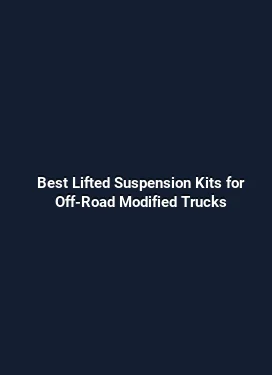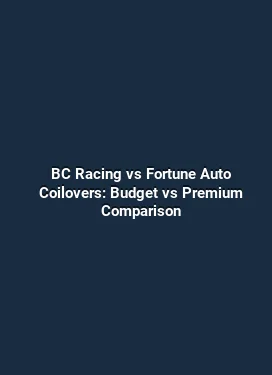Anti-Roll Bar Thickness Calculator: Choosing Right Sway Bar Diameter
Choosing the correct anti-roll bar (ARB) diameter is a nuanced task that blends physics with practical street and track experience. The diameter of a sway bar directly influences roll stiffness, cornering balance, and ride quality by altering how much body roll the suspension allows under lateral acceleration. For enthusiasts and professional tuners alike, a well-sized sway bar helps lock in chassis motion, improving tire contact with the road, predictability, and feedback through the steering wheel. This guide delves into the core concepts, the steps to estimate an appropriate diameter, and concrete, real-world examples to help you tailor your setup for a given vehicle and driving objective.
Fundamentals Behind Sway Bar Sizing

At its essence, an anti-roll bar connects opposite suspension corners to share loads as the vehicle rolls. When a car corners, inner wheels compress while outer wheels extend, causing a transfer of roll stiffness from one side to the other. The sway bar resists this motion by applying a moment that counteracts roll, effectively increasing the wheel–ground contact pressure on the outer tires and reducing body lean. The critical relationship here is between bar diameter and torsional stiffness, which scales with the fourth power of the radius in a solid, standard bar spring model. In practical terms, doubling the diameter dramatically increases roll stiffness, but it also raises suspension loads, influences ride harshness, and alters weight transfer characteristics beneath different grip conditions.
Two common metrics underpin sizing decisions: static roll stiffness and dynamic roll stiffness. Static stiffness refers to the bar’s behavior at small, near-linear sweeps of chassis motion, while dynamic stiffness accounts for large, rapid inputs encountered in aggressive cornering or misalignment scenarios. The target is to achieve a balance where cornering grip is maximized without over-stiffening the front or rear against other suspension components such as springs, dampers, and suspension geometry. In modern sports cars, engineers often tune ARB thickness in concert with body-in-white stiffness, damper rates, and tire development to shape understeer/oversteer characteristics across the speed range.
Key concepts that influence diameter choice

Roll center height, chassis stiffness, axle geometry, and tire compound all interact with sway bar effectiveness. A thicker bar increases roll stiffness more noticeably at higher chassis roll angles, which is beneficial for high-speed cornering but may degrade low-speed maneuverability and ride comfort on uneven surfaces. Conversely, a thinner bar yields a more permissive roll behavior, improving ride quality and grip in slippery conditions but potentially sacrificing cornering stability. The interplay with suspension damping is also critical: stiffer bars often demand revised damper settings to maintain balanced wheel control and prevent abrupt pitch or bounce under dynamic inputs.
How to Determine the Right Thickness: A Practical Framework
Determining the optimal sway bar diameter involves a structured approach that combines desired handling philosophy, vehicle role, and measurable performance targets. The framework below outlines a sequence you can apply to most vehicles, from daily drivers to performance builds.
1) Define the driving objective
Clarify whether the goal is maximized grip in high-speed highway corners, improved mid-corner stability on a track, or a more predictable feel at the limit on a canyon road. A daily driver may benefit from modest bar changes that preserve ride quality, while a performance-focused setup may justify larger diameters paired with coordinated damper tuning. Establish a target lane of behavior: tighten handling, reduce body roll by a specific degree, or sharpen steering response without inducing harshness.
2) Establish baseline measurements
Record current behavior using repeatable tests: a controlled slalom, a fixed-radius corner with steady throttle, and a dip- or bump-assertiveness check to gauge how much body roll occurs under certain lateral accelerations. Note tire temperatures, peak grip indicators, and steering wheel torque at key points. These baselines reveal where the chassis may be under- or over-stiff relative to the tire contact patch and the suspension’s possible range of motion.
3) Start with a conservative increment
Rather than jumping straight to a heavy bar, begin with changes in small steps—e.g., a 5 mm to 8 mm increase in bar diameter on the front or rear as a baseline, depending on where the roll bias needs adjustment. Keep the rest of the suspension unchanged while you evaluate the effect. This reduces the risk of over-constraining body motion and allows you to map the relationship between diameter, ride quality, and slip angle behavior more clearly.
4) Consider the axle distribution and balance
The relative stiffness of the front and rear ARBs shifts the vehicle’s yaw response. A front-heavy increase in stiffness tends to promote neutrality or slight oversteer in cornering, while a rear-dominant stiffening can push the car toward understeer unless compensated elsewhere. For a balanced setup, many drivers tune front and rear diameters in tandem, often using a modest front-bar increase with a corresponding, smaller rear adjustment to retain chassis geometry and weight transfer characteristics.
5) Tie in with damping and spring rates
Sway bar changes effectively alter the wheel rate and the rate at which the suspension resists roll. If dampers are not adjusted, a thicker bar can cause harsher dynamic responses or, in some cases, reduced tire grip due to excessive load transfer. Aligning damper valving, rebound characteristics, and spring rates with the new roll stiffness ensures consistent tire contact and smoother transitions during steering inputs and lane changes.
Material, Construction, and Practical Considerations
The most common sway bars are made from steel, with some high-performance variants using aluminum for weight savings and different stiffness profiles. The geometry—bar length, end link mounting points, and bushing compatibility—also plays a significant role in how a given diameter translates into effective stiffness. A higher-quality bar often features heat-treated alloys, precise torsion springs, and consistent wall thickness along the bar to ensure uniform stiffness across its working range. It is essential to verify compatibility with the vehicle’s suspension geometry and ensure that end links and bushings are rated for the expected increase in bar load. Improperly matched hardware can introduce unwanted binding, premature wear, or non-linear responses that obscure the true effect of diameter changes.
Special attention should be paid to the vehicle’s curb weight, weight distribution, and suspension travel. Heavier cars with stiffer springs may tolerate thicker bars on the front or rear without sacrificing ride quality, while lighter, more supple platforms can quickly become uncomfortable or overly stiff if the diameter is increased too aggressively. When evaluating bars, consider how the bar’s effective length and moment arm interact with the suspension’s anti-squat characteristics and roll couple to maintain desired grip levels across the entire speed range.
Installation notes and tuning checkpoints
Before installing a new sway bar, inspect the mounting points for wear, lubrication, and alignment. After installation, perform a controlled test sequence: straight-line drivability checks, slow-speed steering feel, mid-corner balance, and high-speed cornering stability. Document any changes in steering effort, turn-in response, and the car’s tendency to squat or pitch under braking. A practical rule of thumb is to reassess after a single weekend of mixed driving conditions to confirm the bar’s behavior across scenarios representative of real-world use.
Real-World Scenarios: How Diameter Shifts Change Handling
Consider several representative cases to illustrate how diameter decisions translate into tangible results.
Case A: Daily driver with occasional spirited driving. A subtle front-bar increase by 6 mm coupled with a modest rear-bar adjustment by 4 mm can reduce body roll without notably increasing ride harshness. The steering remains intuitive, and tire wear is kept within a predictable range, thanks to a more even load distribution across the contact patches during cornering.
Case B: Semi-slick track day setup. A larger front ARB diameter may be paired with a calibrated rear bar to improve mid-corner stability and reduce understeer. This setup can allow a driver to carry more speed into turn-in while maintaining tire contact through the apex, provided damper settings are tuned to absorb the heavier roll resistance and prevent chassis oscillation.
Case C: Lightweight sports car on a bumpy road. In this scenario, a slight reduction in diameter on the rear bar can help preserve ride quality and maintain grip on undulating surfaces, especially when tire compliance is a limiting factor. The emphasis here is on maintaining a balanced chassis that communicates tire slip without excessive body movement.
Measurement Techniques and Tools for Verification
To move beyond subjective impressions, practitioners often use a mix of on-car measurements and data logging. Wheel rate data, yaw rate, lateral acceleration, and steer angle are metrics that can be captured with modern data loggers and advanced chassis instrumentation. Analyzing how these signals shift with the change in bar diameter provides objective insight into roll stiffness distribution and overall handling balance. A practical approach is to monitor the correlation between lateral grip and steering input as you vary diameter, looking for smoother transitions and reduced abruptness in yaw response under rapid direction changes.
Technicians may also employ simple ride-height and corner-weight measurements to ensure that geometry remains within acceptable tolerances after installation. A small change in bar stiffness can subtly alter weight distribution under load, so rechecking corner weights ensures that the suspension geometry remains aligned with desired targets. When the vehicle has adaptive damping or electronically controlled suspension, consult the system’s calibration guidance, as these systems may adapt to bar changes in real time, masking some effects without careful data collection.
Common Myths and Misconceptions About Sway Bars
One frequent misconception is that a thicker bar always improves handling. In reality, the optimal diameter depends on the entire suspension ecosystem, including springs, dampers, tires, chassis rigidity, and weight distribution. Another misconception is that the front bar alone determines understeer or oversteer. In truth, both front and rear ARBs interact with the vehicle’s overall dynamics, and a balanced combination often yields the best controllability and steering feedback. Finally, there is a belief that stiffer is always better for track performance. This is not universally true; excessive stiffness can cause tire scrubbing, loss of grip under abrupt inputs, and uncomfortable degradation of ride quality on uneven surfaces.
Practical Guidelines for Specific Vehicle Types
Different vehicle archetypes respond uniquely to sway bar adjustments. For front-engine rear-drive cars with a tendency toward understeer, a careful increase in the front bar relative to the rear can sharpen turn-in and reduce mid-corner push. In mid-engine layouts where balance is critical, a symmetrical or slightly rear-biased approach can help preserve neutral behavior around the apex. For front-wheel-drive machines, ensuring that the front bar size does not overly burden the driven wheels with roll stiffness is essential to avoid torque-steer-like effects and loss of traction under acceleration. In all cases, iterative testing and data-driven assessment yield the most reliable path to the desired handling characteristics.
The ultimate aim is a chassis that communicates predictably, maintains tire contact through the corner, and preserves a comfortable, confident ride. A thoughtful, staged approach to sway bar sizing—paired with compatible damping and spring settings—can unlock a chassis’s potential without sacrificing everyday drivability.






